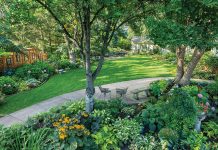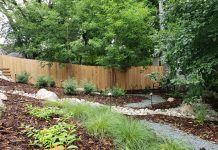
After a long, exhaustive search for a home, my husband Aaron and I signed a purchase agreement in March and closed on our new home last week. To say I’m excited is an understatement. This new home holds so much promise: It will be the first time in my adult life that I’ll have the luxury of parking in a garage (no more street parking in winter! No more moving my car during snow emergencies!), it will be the first time I’ll have a pantry (does this mean I’ll have uncontrollable impulses to buy in bulk?), and it will be the first time we attempt to plant a vegetable garden.
I’ve been entertaining the garden idea for years. In our previous home, the purpose of the backyard was to give our little boys a place to run and play freely, and provide our friends with a gathering spot for burgers and cold beer. This new house, though, has “vegetable garden” written all over it. (The previous homeowners had multiple gardens. I’m hoping they primed the soil for our experiment.) The yard is big enough that a garden won’t take away from running/playing space for the boys.
I don’t have a clue how to garden. Both of my parents grew up on farms, and yet the farming gene completely escaped me. I don’t have a green thumb. I have never planted a seed and nurtured it. I have never had to weed anything, or keep pests away from it, or wear gloves for anything other than winter activities. I have never had to check on a plant to make sure it’s doing ok, but I want the satisfaction of growing something, and I want my kids to know where their food comes from. And let’s be honest, I want to eat tomatoes. After doing a little research, my mind is reeling with all that I don’t know about gardening. I hope to learn as I go, though. Ya gotta start somewhere, right!?
Spring planting tips from the pros:

- Find an area that will get full sun (unless you only want to plant lettuce and spinach).
- Make sure you have a water source nearby to prevent drought, and remember that city water isn’t free.
- If planting vegetables in a row, Better Homes and Gardens recommends allowing at least 18 inches between the rows to work between them. “And as you sketch out your plan, place taller vegetables at the north side of the garden. This includes naturally tall plants—like tomatoes—and plants that can be grown on vertical supports, including snap peas, cucumbers, and pole beans.”
- Test your soil—the precious life-blood of your garden—before planting. Soak the soil with a hose, wait a day, dig up a handful of soil, and give it a hard squeeze. Does water stream out? If yes, you may need to add compost. Does the soil form a ball? If yes, throw it at the nearest person (kidding!). If it doesn’t form a ball, your soil might be too sandy, and you might want to add organic material. Does the soil stick together, even when you poke it? There could be too much clay, and you might want to add organic matter, like sawdust or leaves. When the soil is “just right” (I feel like I’m reading Goldilocks and the Three Bears), the ball will crumble, like cake.
- When you’ve mapped out a site for the garden and are ready to plant, you first must loosen the soil, or in official gardening speak, till it. Get out the rake! You don’t have to go very deep—less than a foot is best. Edge the garden bed with an 8-inch trench.

- Once you’ve planted your seeds, make sure they’re not thirsty. That means about an inch of water per week, or watering once or twice a week if there isn’t rain in the forecast. And try to water early in the day, and target the soil rather than the leaves of the plants, or you might wind up with fungal diseases. Talk and sing to your plants: thespruce.com
- Weed control. I gotta be honest, I am not looking forward to this chore. I learned that gardens actually need weeds, they’re nature’s healing remedy, and I also learned that my idea of weeding may have been wrong all along. When our previous lawn was overcome with dandelions, it was gratifying to pull them out by the root. Turns out that this digging can bring hidden “weed seeds”—seeds that had been happily lying there in the dirt, dormant—up to the surface, where they THEN get enough light to trigger germination. I picture these little weed seeds slumbering peacefully in the soil until they’re “disturbed” by us, then visualize them proclaiming in an evil voice, “Bwahahaha! I’m alive!” Rather than messing with the soil, some experts suggest killing weeds at the roots with a sharp knife. This way, you’re not disturbing the dormant weed seeds. I read that you should only dig when you need to, then immediately “salve” the disturbed spot with plants or mulch. I also didn’t realize that “ideal” weeding conditions are after a hard rain, and when you can’t remove weeds, the next best thing is beheading them to make sure they don’t have a chance to spread their seeds. (Do I need to buy pruning shears?)
- I might change my mind, but right now I don’t like the thought of weed-killing chemicals in my garden. Alternatives include vinegar (mix a tablespoon of dish detergent and two tablespoons of vegetable oil with a gallon of white household vinegar, spray it directly on weeds. Don’t spray on windy/breezy days), corn gluten meal, and commercial organic herbicides.
- Mulch. The purpose of mulch is to keep the soil cool and moist and deprive weeds of light. The less time spent weeding, the better. Options include organic mulch, grass, wood chips, compost, or what my grandma did—lay down sheets of black plastic film.

- When vegetables grow, they strip nutrients from the soil (just by growing!), so the purpose of fertilizer is to help “feed” your garden by putting some of those nutrients back. But what, exactly, do those NPK numbers mean on a bag of fertilizer? (I was never good at math and seeing numbers that make no sense is bringing back some serious feelings of inadequacy.) The first number is the percentage of nitrogen (lawns and sweet corn thrive with this nutrient), the second number phosphorous or phosphate (produces more flowers and fruit), and the last potassium, or potash (help plants process all nutrients more efficiently). From what I understand, the ideal ratio for flowering plants is 3-1-2; the higher the numbers, the more chemical salts are added. If I want to use organic fertilizer, looks like I have a lot more research ahead of me.
- Pest control. Before I declared my major as journalism, I considered entomology, or the study of insects. I think (most) bugs are fascinating, I just don’t want them chewing up my garden. Maybe I’ll plant basil, lavender, or marigolds to help keep aphids, mosquitoes, and silverfish away. I honestly don’t know how to deter rabbits and deer other than fencing. I’d love any tips you may have.
Just compiling this list is giving me anxiety, but I keep thinking about those tomatoes … and the pride we’ll feel knowing we grew them on our own. Happy gardening!
By Chrissy Sarinske



















